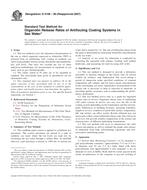We need your consent to use the individual data so that you can see information about your interests, among other things. Click "OK" to give your consent.
ASTM D5286-01(2011)
Standard Test Methods for Determination of Transfer Efficiency Under General Production Conditions for Spray Application of Paints
STANDARD published on 1.6.2011
The information about the standard:
Designation standards: ASTM D5286-01(2011)
Note: WITHDRAWN
Publication date standards: 1.6.2011
SKU: NS-30588
The number of pages: 5
Approximate weight : 15 g (0.03 lbs)
Country: American technical standard
Category: Technical standards ASTM
The category - similar standards:
Annotation of standard text ASTM D5286-01(2011) :
Keywords:
general production conditions, solvent emission, spray applied coatings, transfer efficiency, VOC, volatile conten, General production conditions, Paint solids, Solid phase materials--paints/related coatings/materials, Solvent emissions, Spray-applied coatings, Transfer efficiency (TE), Volatile organic compounds (VOC)--paints/related coatings, ICS Number Code 87.040 (Paints and varnishes)
Additional information
| Significance and Use | ||||||||||||||||||
|
Subject to the limitations listed in 1.3, these test methods can be used to optimize paint application processes. |
||||||||||||||||||
| 1. Scope | ||||||||||||||||||
|
1.1 These test methods cover the determination of the transfer efficiency of spray-applied coatings under general plant conditions. Transfer efficiency is the ratio of paint solids deposited to the total paint solids used during the application process, expressed as a percent. 1.2 The transfer efficiency is calculated from the weight or volume of the paint solids sprayed and that of the paint solids deposited on the painted part. 1.3 Limitations include the ability to accurately determine the amount of paint solids deposited on the part and the capability of accurate measurement of the amount of paint sprayed. 1.4 The values stated in SI units are to be regarded as the standard. The values given in parentheses are for information only. Note 1—These test methods apply to general plant production equipment and procedures. A method specific to automotive plants is defined in Test Method D5066. Note 2—The relationship between volatile organic compound emission rates and transfer efficiency in automobile and light duty truck topcoat operations, EPA 450/3-88-01, referenced in Test Method D5066 does not apply to general production facilities. Note 3—A single-point transfer efficiency measurement may not represent the entire process. Note 4—The operator and the spray-application equipment-operating conditions during the transfer efficiency measurement should be representative of normal operating conditions. 1.5 This standard does not purport to address all of the safety concerns, if any, associated with its use. It is the responsibility of the user of this standard to establish appropriate safety and health practices and determine the applicability of regulatory limitations prior to use. For specific hazard statements see Section 7, and 10.3.1. Note 5—These test methods have not been adopted by federal regulatory agencies for demonstration of compliance with air pollution regulations such as VOC, HAPS, etc. |
||||||||||||||||||
| 2. Referenced Documents | ||||||||||||||||||
|
Similar standards:
Historical
1.7.2014
Historical
1.12.2010
Historical
1.6.2007
Historical
1.7.2010
Historical
1.7.2014
Historical
1.6.2010
We recommend:
Technical standards updating
Do you want to make sure you use only the valid technical standards?
We can offer you a solution which will provide you a monthly overview concerning the updating of standards which you use.
Would you like to know more? Look at this page.



 ASTM D5087-02(2014)..
ASTM D5087-02(2014).. ASTM D5098-05a(2010)..
ASTM D5098-05a(2010).. ASTM D5108-90(2007)..
ASTM D5108-90(2007).. ASTM D5125-10
ASTM D5125-10 ASTM D5145-09(2014)..
ASTM D5145-09(2014).. ASTM D5146-10
ASTM D5146-10
 Cookies
Cookies
